As May turns into June and spring advances towards summer, birders in southern Ontario have less and less to do. The migrant warblers that keep us on the chase in May have, except for a few resident species, moved on to their northern breeding grounds, and many of the birds that stay behind, busy raising their broods, have started to fall silent and retreat to the now fully-leafed-out cover of the woodland canopy. Birders, in short, need something to keep them occupied, and for some of us this means turning to the emerging crop of damselflies and dragonflies. June and July are the peak damselfly- and dragonfly-watching months here, and with Ryan and his brothers still with us in Canada I could justify an insect-hunting expedition or two in June 2015 as part of my schedule of grandpa-grandson bonding experiences (sometimes, admittedly, under some protest from Ryan).
The best dragonfly spots near Toronto and Mississauga, so I had been told, are actually well west of the city in the vicinity of Cambridge and Puslinch. June 6, therefore, found us exploring the Shade's Mills Conservation Area on the Grand River near Cambridge. Shade’s Mills turned out to be quite an attractive place, a combination of hardwood forest...
...and waterside that proved to be attractive to both insects...
Southern Ontario sits on the border between the ranges of two spectacular, but very similar, butterflies, the Eastern and Canadian Tiger Swallowtails (Papilio glaucus and P. canadensis). Unfortunately these photos don’t make it clear (at least to me) which of the two this is. The best way to tell is to check whether the spots in a row on the underside of the forewing edge butt up against each other (Canadian) or not (Eastern).
I at first took this for the smaller and daintier Fragile Forktail (Ischnura posita), usually best identified by the ‘exclamation mark’ on the thorax, but the Fragile Forktail never has blue on the tip of the abdomen. This is, then, simply another male Eastern Forktail, but one with an interrupted shoulder stripe – something that turns up not infrequently.
For a final image from Shade’s Mills, here is a Wood Frog (Lithobates sylvaticus) that Ryan and I found, appropriately, in the woods. Wood Frogs are northern, highly cold-tolerant animals, and unlike other ranid frogs are more creatures of the forest floor than the water’s edge.
I mentioned the Darner family (Aeshnidae) earlier in this post, but didn’t include any photos. Darners are difficult to photograph because, unlike skimmers, clubtails and emeralds, they rarely perch during their hunting sessions. I was therefore very pleased, during a brief excursion on June 21, to come across a mating pair of Common Green Darners (Anax junius) conveniently perched at close range. Here is the result.
After all, you never know what a few judicious pokes might turn up: perhaps, with luck, a frog or two (in this case, a Northern Leopard Frog (Lithobates pipiens) hunkering down among the grass stems).
While Ryan checked for frogs, I concentrated on attractive waterside plants like this blooming Yellow Iris (Iris pseudacorus)...
...or at least they spend a fair bit of time wandering around locked together, the male clinging to the female like a frog in amplexus.
It’s not easy to find a Forest Tent Caterpillar (Malacosoma disstria) on its own. It’s much more common to find masses of these colonial caterpillars, hiding within their silken enclosures from predators such as cuckoos (my old mentor, the late Professor J. Murray Speirs, used to refer to tent caterpillar colonies as “cuckoo food”).
The Delaware Skipper (Anatrytone logan) is an uncommon butterfly in Canada, but it has been spreading in southern Ontario in recent years.
Southern Ontario sits on the border between the ranges of two spectacular, but very similar, butterflies, the Eastern and Canadian Tiger Swallowtails (Papilio glaucus and P. canadensis). Unfortunately these photos don’t make it clear (at least to me) which of the two this is. The best way to tell is to check whether the spots in a row on the underside of the forewing edge butt up against each other (Canadian) or not (Eastern).
In recent years a warming climate has allowed Giant Swallowtails (Papilio cresphontes) to stage an invasion of much of southern Ontario. Previously confined, at least in our province, to the Carolinian lowlands of the southwest, Giants have begun appearing over a far wider area.
Their distribution is probably limited here by the availability of larval food plants. The orange groves that feed broods of Giant Swallowtails in places like Florida are not available here, and their caterpillars have to make do with related substitutes such as Hoptree (Ptelea trifoliata), a relatively rare plant in Ontario, and Prickly-Ash (Zanthoxylum americanum).
As for the objects of our expedition, Shade’s Mills proved to be a good spot for both of Ontario’s brilliant jewelwing damselflies (Calopteryx spp).
The Ebony Jewelwing (Calopteryx maculata), as usual the commoner of the two, must be one of the most elegant of its kind. The male, his broad black wings draped over his deeply iridescent body, looks downright aristocratic.
The other species, the River Jewelwing (Calopteryx aequabilis), is not quite a match for the Ebony. Its wings are not as broad, and the black is confined to the wingtips it is, of course, a very handsome insect all the same.
The females of the two species are a bit harder to tell apart, but the female River Jewelwing (lower photograph) does have a duller version of the male’s wing pattern. Both sexes have, as I noted for the male, narrower wings than in the Ebony Jewelwing (upper photograph).
We found both jewelwings posing, in typical fashion, on the upper surfaces of leaves along trails through the forest. These are Ebony Jewelwings.
In addition to both species of local jewelwing, we also found numbers of Eastern Forktails (Ischnura verticalis). The upper insect is an adult male. Young female Forktails are heteromorphic (that is, they coe in more than one colour), and may be orange-and-black (middle) before settling down to the mostly blue colour of the adult (bottom).
I at first took this for the smaller and daintier Fragile Forktail (Ischnura posita), usually best identified by the ‘exclamation mark’ on the thorax, but the Fragile Forktail never has blue on the tip of the abdomen. This is, then, simply another male Eastern Forktail, but one with an interrupted shoulder stripe – something that turns up not infrequently.
The commonest of our damselflies are probably the Bluets (Enallagma spp). Finding them is easy, but identifying them - short of catching them, which I don’t like to do, and examining their genitalia with a hand lens - can be difficult to impossible.
Of the several dragonfly families recorded from Ontario one - the Libellulidae, or Skimmers - normally accounts for most of the dragonflies one is likely to see and photograph, including these Common Whitetails (Plathemis lydia). The upper photograph shows an adult male; the other two are females.
Other than that, the family I encounter most often is the Gomphidae, or Clubtails, easily identified by their damselfly-like eyes that do not, as in most other dragonflies, meet across the top of the head.
I found two common species sitting (as they typically do) on the open ground. These are Lancet Clubtails (Phanogomphus exilis).
This is the very similar Ashy Clubtail (Phanogomphus lividus). Alert readers will notice that when I have shown these two species in previous posts I have listed them in the genus Gomphus. Gomphus, though, has now been split into a number of genera according to the regularly-updated World Odonata List, and who am I to argue?
This is the very similar Ashy Clubtail (Phanogomphus lividus). Alert readers will notice that when I have shown these two species in previous posts I have listed them in the genus Gomphus. Gomphus, though, has now been split into a number of genera according to the regularly-updated World Odonata List, and who am I to argue?
Anyway, the split is based on a 2017 study that was the first to examine North American Gomphidae using molecular evidence. According to the study, as it turns out, none of the North American dragonflies included in the genus Gomphus actually belong there. Who knew?
With the exception of the Aeshnidae, or Darners, I had, so far, had miserable luck (or simply lousy locating skills) with Ontario’s other dragonfly families. This was particularly galling for the Corduliidae, or Emeralds. Ontario actually has lots of corduliids, but my experience with them had been limited to brief, distant looks and poor photographs. My luck changed at Shade’s Mills, at least with respect to the commonest (and, I suppose, easiest to see) genus of corduliids, the baskettails (Epitheca spp.)
Baskettails seemed to be pretty much everywhere at Shades Mills, at least in more open areas. They proved to be distinctive creatures, with their colorful eyes, hairy bodies and habit of clinging to vertical perches while holding their bodies diagonally or even horizontally - a position that, for a human gymnast, would be challenging in the extreme, but seems normal for this dragonfly family.
Identifying Baskettails to genus is comparatively easy (though, in my subsequent encounters with them, I have misidentified then more than once), but sorting out the species can be a lot trickier. The key, again, is the shape of the genitalia. In the Spiny Baskettail (Epitheca spinigera) there is, indeed, a tiny spine projecting down from the underside of the upper male claspers (or cerci). You can just see it in these photographs.
The spine is lacking in the Common Baskettail (Epitheca cynosura), a distinction I did not notice until I examined my photographs at home. Just to make things slightly easier, the Common is more likely than the Spiny to have a patch of black at the base of the hindwing.
For a final image from Shade’s Mills, here is a Wood Frog (Lithobates sylvaticus) that Ryan and I found, appropriately, in the woods. Wood Frogs are northern, highly cold-tolerant animals, and unlike other ranid frogs are more creatures of the forest floor than the water’s edge.
I mentioned the Darner family (Aeshnidae) earlier in this post, but didn’t include any photos. Darners are difficult to photograph because, unlike skimmers, clubtails and emeralds, they rarely perch during their hunting sessions. I was therefore very pleased, during a brief excursion on June 21, to come across a mating pair of Common Green Darners (Anax junius) conveniently perched at close range. Here is the result.





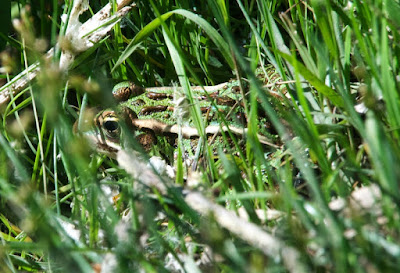






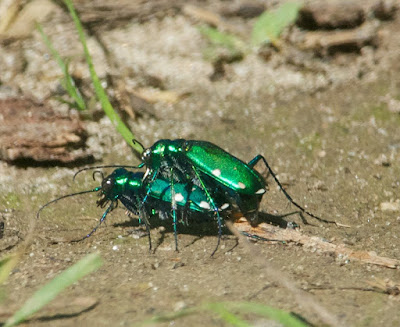




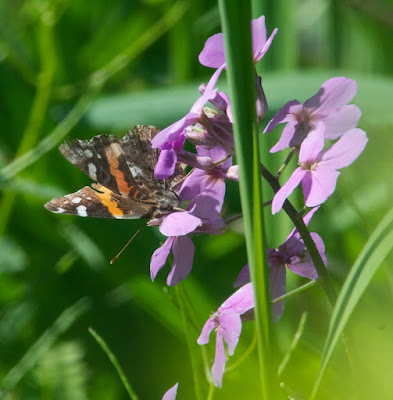

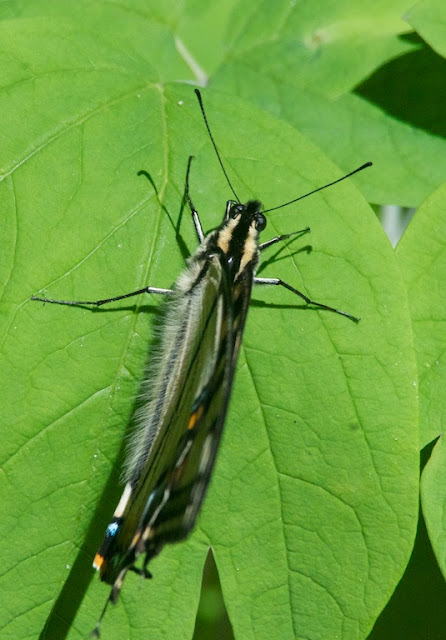


















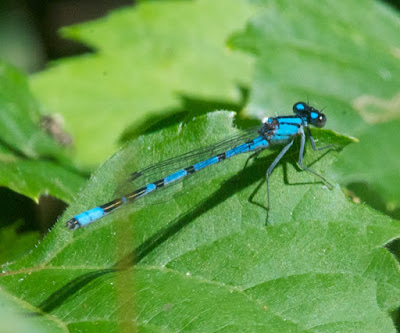








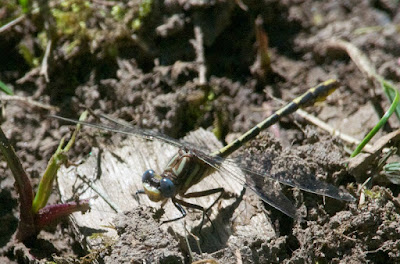

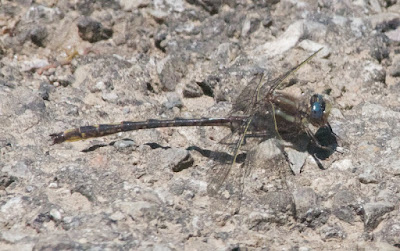









No comments:
Post a Comment